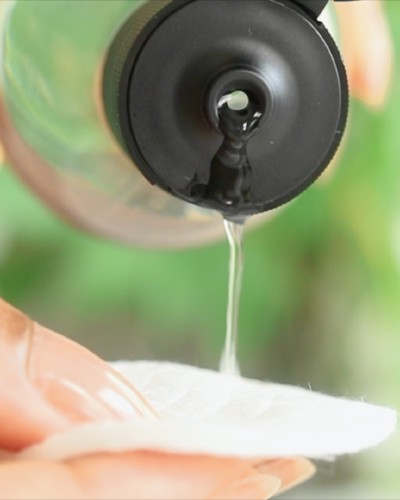A crystal clear, light cleansing micellar water that’s perfect for removing makeup and sensitive skin.
Ingredients
Phase 1
- 235g Distilled Water
- 7.5g Cocamidopropyl Betaine
- 5g Pentylene Glycol
- 2.5g Cucumber Extract
Phase 2
- A couple drops of Lactic Acid
- 2.5g Preservative of choice
Method
- Measure out the phase one ingredients: Distilled Water, Cocamidopropyl Betaine, Pentylene Glycol and Cucumber Extract.
- Mix together in a large container, it might initially have a cloudy appearance, but it should settle to a clear solution
- Check and adjust the pH: using a pipette, add a couple drops of lactic acid to balance the pH between 5.0 and 5.5. You can also use citric acid diluted in water.
- Add your preservative of choice and mix one last time to ensure that it is fully incorporated.
- Store your DIY micellar water in a bottle with a flip cap or applicator lid for ease of use.
This recipe makes 250g of DIY micellar water and will last for approximately 6 months, see the formula calculator to adjust amounts.
How does micellar water work?
There is a lot of technical jargon around micellar waters, but they are essentially just surfactants diluted in water with some moisturising elements added. Micellar waters work by hydrophilic “water-loving” and hydrophobic “water-hating” or “oil-loving” working together to break down oil, dirt, makeup, debris and neutralise them with water.

In addition to their cleansing abilities, micellar waters also have a toning effect on the skin, leaving it soft, hydrated and even moisturised.
This is in sharp contrast to traditional makeup removers that often agitate the skin after stripping away makeup and moisture. Micellar waters are even gentle enough to remain on the skin!
For these reasons, micellar waters have become a favourite amongst makeup wearers and general skincare enthusiasts as a gentle, effective way to clean and tone skin.
Substitutions
Pentylene Glycol is a naturally derived glycol that is a powerful humectant and solvent. It is an essential component that greatly contributes to the moisturising and hydrating effects of toner. However, if you are unable to find this you could use another glycol such as butylene, propylene or propanediol. Please note that most propylene & butyl Glycerine is not as effective but it can still be used as a natural humectant alternative.
Cucumber Extract has well documented anti-inflammatory and soothing effects on the skin, helping to tone and balance sebum levels. This could also be substituted for green tea or chamomile extract which are also amazing antioxidants.
Natural surfactants for micellar waters
Cocamidopropyl Betaine

Coco-Betaine
Coco-Betaine is a natural surfactant, often confused with Cocamidopropyl Betaine. Whilst both are derived from coconuts, coco-betaine is actually a natural surfactant, whilst Cocamidopropyl betaine is considered “semi-synthetic” or completely synthetic. The two should not be used interchangeably, as whilst coco-betaine is a natural surfactant, it is also more irritating on the skin and not used in mild cleansers or baby products. However, if you are looking for completely natural micellar water, you can try using coco-betaine.

Decyl Glucoside or Caprylyl/Capryl Glucoside
Staple natural surfactants, both caprylyl/capryl glucoside and decyl glucoside will work well in micellar formulas due to their mild but effective cleansing abilities. Unlike Cocamidopropyl betaine, they have a thicker, more viscous texture that may be slightly noticeable in the final micellar formula but it won’t affect its application. It’s worth noting that they also have a distinctive scent that is difficult to mask with hydrosols, so if you prefer an odourless micellar formula - I would recommend using an alternative surfactant.
They are non-ionic surfactants and therefore carry a high pH that will need to be adjusted to between 5.0 and 5.5 to reduce irritation for extremely dry or sensitive skin.
Please note that your skin can experience sensitivity to any ingredient, even if it is considered mild, it is always advised to do a “patch test” first before applying new cosmetics.
